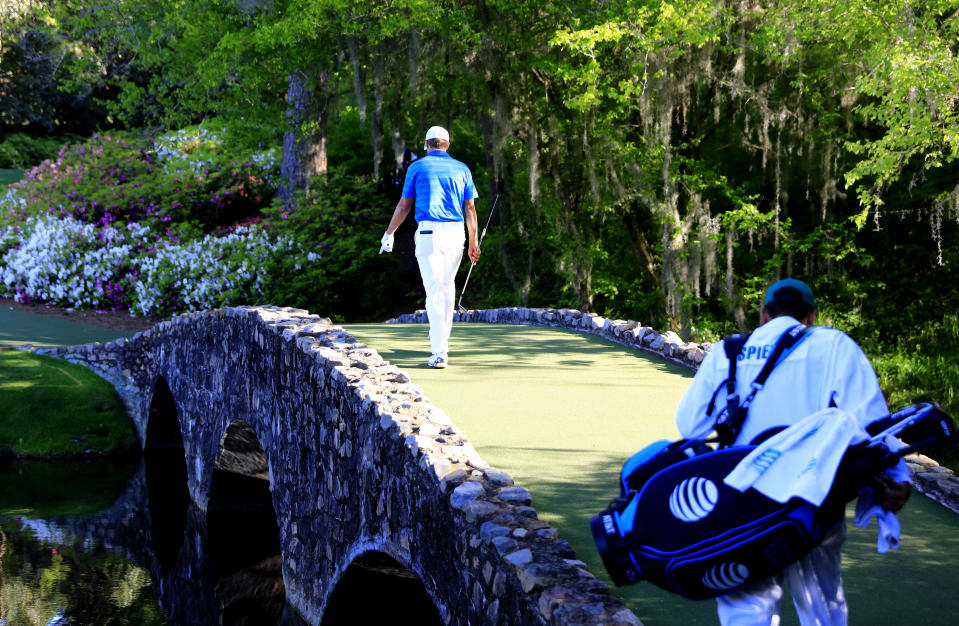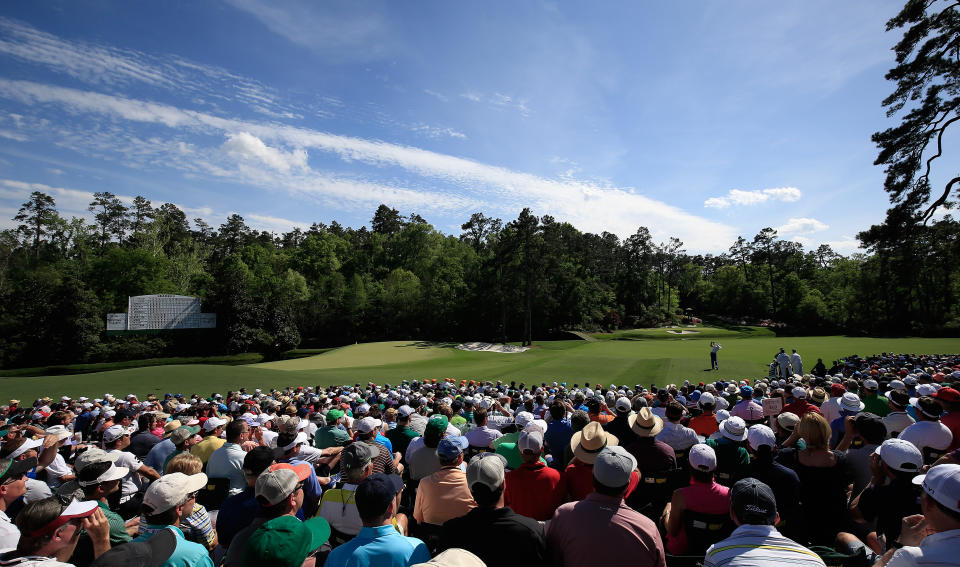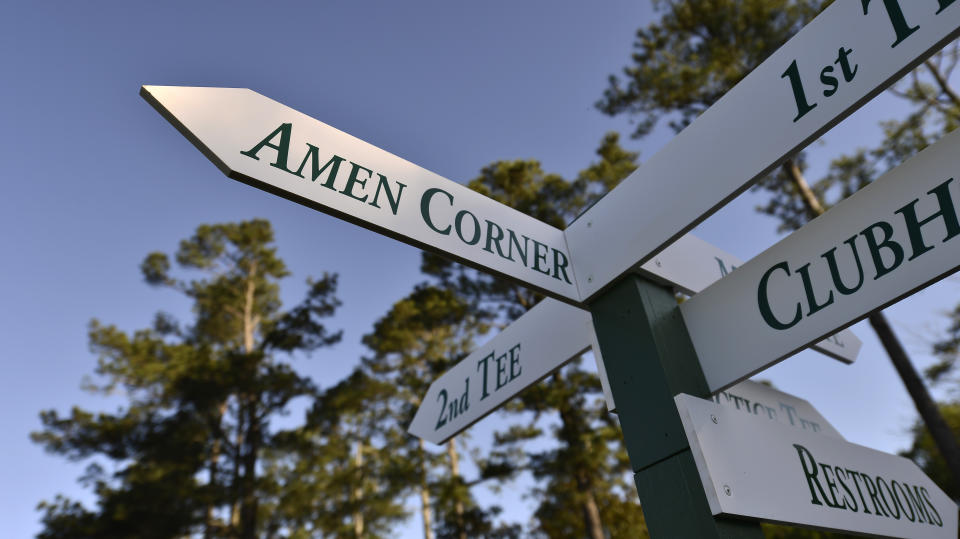Masters 2020: The wicked psychology behind Amen Corner
Jordan Spieth tapped in his putt at the 9th. He was leading the Masters by five strokes. He and caddie Michael Greller thought they realized something: if Spieth just parred his way around Augusta’s second nine, they’d win the Masters.
Spoiler: It was 2016. He didn’t, and they didn’t.
Three holes later, Spieth became one of the most high-profile victims ever of Augusta’s Amen Corner, quadruple-bogeying the hole to surrender the lead and, ultimately, what would have been a second consecutive green jacket.
Named by golf writer Herbert Warren Wind, the source of a hundred thousand motivational break room and man cave prints, Amen Corner comprises parts of three holes on Augusta’s back 9: the approach and green of No. 11, “White Dogwood”; the entirety of the par-3 12th, “Golden Bell”; and the first shots of no. 13, “Azalea.”
It’s beautiful and treacherous all at once. The 11th and 12th holes rank as the second- and fourth-most difficult on the course, respectively, and feed directly off the toughest, No. 10.
“There’s a perfect psychological storm that happens at Amen Corner,” says Dr. Joe Parent, an author and performance psychologist whose clients have included Vijay Singh and Cristie Kerr. “It’s not that the holes are that difficult. I believe it’s named because of the stress that risk-reward brings in for those holes.”
Each hole has its own set of risk-reward parameters. The approach at 11 carries the risk of ending up in the water. Same for 13, where you can try for a heroic shot to set up an eagle, the way Phil Mickelson did from the pine straw in 2010 … but you can just as easily end up in the rivulet of Rae’s Creek that curls around the hole.
And then there’s 12, the ultimate big-gamble hole. At the lowest point on the Augusta National property, it’s completely fronted by Rae’s Creek. Swirling winds wreak havoc on balls lofted to clear the creek. And the green itself is an optical illusion; it sweeps back and to the right, away from the tee box, so a shot that will reach the front edge of the green will tumble down a hill and into the drink if you’re aiming for the Sunday pin placement.
Spieth in 2016 was just the latest of Golden Bell’s many notable victims. Arnold Palmer also lost a chance at a second consecutive victory when his shot also hit the creek. Greg Norman’s 1996 collapse suffered in part because of a wet shot on 12. And Tom Weiskopf carded the highest score in Masters history on the hole with a 13 in 1980.
“It was a lack of discipline to hit it over the bunker coming off two bogeys, instead of recognizing I was still leading the Masters,” Spieth said in 2016. “It was a really tough 30 minutes for me that hopefully I never experience again.”

Amen Corner poses a severe challenge on both the physical and mental fronts. You’re two-thirds of the way through your round, so you’re starting to run out of energy, particularly if you haven’t properly hydrated. (Golfers at Augusta can sidestep the temptation to grab a chili dog at the turn, but what they choose to pack in their bags says a lot about how much energy they’ll have to go the distance.) Six holes from the finish, you’re too far back to start your kick, so to speak; you can’t ride sheer adrenaline back up the hill to the 18th hole.
There’s another wicked element about Amen Corner, Parent notes: there’s not much room left to make up for a mistake. You double-bogey the sixth hole, you’ve got 12 to make it up. You double-bogey the 12th, and you’re running out of time to bring your scorecard back in line.
“When you start to see the finish line, you start to worry about mistakes,” Parent says. “Right around Amen Corner, your game plan can change, and that’s a very damaging thing.” Instead of aggression, players start playing not to make a mistake. Swings become tentative, shots drift off target, putts roll too far or not far enough.
Which brings us back around to Spieth, and his unwise, uncharacteristically tentative declaration coming off the 9th.
“Do you think he said [parring the second nine would win] on the first tee? Absolutely not,” Parent says. “He changed his game plan with a five-shot lead … Did he lose [the Masters] on 12? No. He lost it walking off the ninth green.”
Parent recounts the tale of one of his clients, who was working his way through the final round of Q School, hoping to play his way onto the PGA Tour, and eagled the 16th hole. “I got it, I made it!” he thought.
You can guess what happened next. He bogeyed the next two holes and missed getting his PGA Tour card by one stroke. Parent’s advice to the player was simple and direct:
“What you said to your brain is, ‘We got this, we’re done.’ And your brain said, ‘Cool. We should have a beer in the clubhouse.’ All focus disappears.”
The correlation between Amen Corner success and a Masters victory isn’t exact, but it’s a helpful barometer for who might survive the crucible. Since 1983, according to Decade Golf, the lowest total score relative to par in Amen Corner is Phil Mickelson’s -33, but that’s over the course of 306 holes played. (Second: Tiger Woods at -30, over 258 holes. No one else is within 13 strokes.)
Per-hole stats tell us more. Jon Rahm ranks second only to Constantino Rocca in shots gained per hole at 0.301 — in other words, he’s gaining an average of almost a full shot on the field every time he passes through those three holes. (Given Rahm’s proclivities for an on-course meltdown, that’s something of a shock.)

It’s no surprise, then, that Rahm is, per BetMGM, one of the favorites at this year’s Masters at +1000. Two other favorites, Bryson DeChambeau (+800) and Patrick Cantlay (+2500), are among the lowest average scorers on 12, averaging 2.83 and 2.80 strokes on the par 3, respectively. Granted, all three of these players probably have a whole lot of Amen Corners, and likely a few crooked numbers, ahead of them, but starting strong is a good way to carry momentum forward into future rounds.
For anyone facing Amen Corner — whether the real thing, or some metaphorical version in their own game — Parent has a few tips. First off, slow down.
“Tom Watson was known for choking at U.S. Opens. He said, ‘I started winning when I started walking more slowly and doing breathing exercises,” Parent says. “Jack Nicklaus walked in like a big cat stalking its prey, deliberately looking sideways at the target.”
Parent advocates a two-step plan: “One, give myself the best chance for birdie,” he says, “two, without taking unnecessary risk.” Going for birdie on the par-5 13th is a reasonable risk; going for it on the par-3 12th might not be.
Plus, Parent believes in the idea of “positive intentionality” — staying focused on a target with the proper degree of aggression, not tentative hold-onto-my-lead passivity. “That’s why Tiger [Woods] is such an amazing closer,” Parent says. “He’s said many times, ‘If I’ve got a six-shot lead, I’m doing everything I can to make it a seven-shot lead.”
And speaking of Tiger … for an object lesson in how to turn Amen Corner to your advantage, you don’t need to look any further than last year. Woods was two strokes off the lead coming into Sunday, and two strokes off the lead coming into Amen Corner. But four of the seven players within three strokes of the lead proceeded to dunk their shots in the water at 12. Woods, meanwhile, calmly played to the center of the green rather than the flag.
Two putts and one tee shot later, he left Amen Corner with a share of the lead, and he hasn’t relinquished it to this day. That’s how you do Amen Corner right.
“If there’s one hole that will reveal whether or not someone has what it takes to win the Masters, it’s No. 12,” Golf Channel commentator Brandel Chamblee said on his podcast earlier this week. “That hole is an X-ray machine. Does this person have it, or does he not?”

_____
Jay Busbee is a writer for Yahoo Sports. Follow him on Twitter at @jaybusbee or contact him with tips and story ideas at jay.busbee@yahoo.com.
More Masters coverage from Yahoo Sports

 Yahoo Finance
Yahoo Finance 